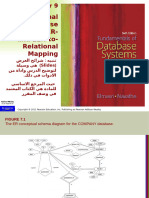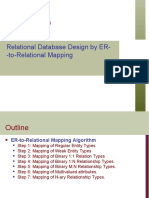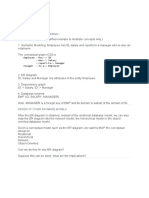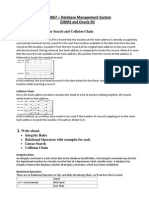L 4
L 4
Uploaded by
kenenisa AbdisaCopyright:
Available Formats
L 4
L 4
Uploaded by
kenenisa AbdisaOriginal Title
Copyright
Available Formats
Share this document
Did you find this document useful?
Is this content inappropriate?
Copyright:
Available Formats
L 4
L 4
Uploaded by
kenenisa AbdisaCopyright:
Available Formats
Chapter 7
Relational Database Design by
ER- and EER-to-Relational
Mapping
Copyright © 2004 Pearson Education, Inc.
5.5
Elmasri/Navathe, Fundamentals of Database Systems, Fourth Edition Chapter 7-3
Copyright © 2004 Ramez Elmasri and Shamkant Navathe
5.6
Elmasri/Navathe, Fundamentals of Database Systems, Fourth Edition Chapter 7-4
Copyright © 2004 Ramez Elmasri and Shamkant Navathe
Chapter Outline
ER-to-Relational Mapping Algorithm
Step 1: Mapping of Regular Entity Types
Step 2: Mapping of Weak Entity Types
Step 3: Mapping of Binary 1:1 Relation Types
Step 4: Mapping of Binary 1:N Relationship Types.
Step 5: Mapping of Binary M:N Relationship Types.
Step 6: Mapping of Multivalued attributes.
Step 7: Mapping of N-ary Relationship Types.
Mapping EER Model Constructs to Relations
Step 8: Options for Mapping Specialization or Generalization.
Step 9: Mapping of Union Types (Categories).
Elmasri/Navathe, Fundamentals of Database Systems, Fourth Edition Chapter 7-5
Copyright © 2004 Ramez Elmasri and Shamkant Navathe
FIGURE 7.1
The ER
conceptual
schema
diagram for
the
COMPANY
database.
Elmasri/Navathe, Fundamentals of Database Systems, Fourth Edition Chapter 7-6
Copyright © 2004 Ramez Elmasri and Shamkant Navathe
ER-to-Relational Mapping Steps
Step 1: Mapping of Regular Entity Types.
– For each regular (strong) entity type in the ER schema, create a
relation R that includes all the simple attributes of E.
– Choose one of the key attributes of E as the primary key for the
relation.
Example:
We create the relations EMPLOYEE, DEPARTMENT, and
PROJECT in the relational schema corresponding to the regular
entities in the ER diagram.
SSN, DNUMBER, and PNUMBER are the primary keys for the
relations EMPLOYEE, DEPARTMENT, and PROJECT as shown.
Elmasri/Navathe, Fundamentals of Database Systems, Fourth Edition Chapter 7-7
Copyright © 2004 Ramez Elmasri and Shamkant Navathe
FIGURE 7.2
Result of
mapping the
COMPANY
ER schema
into a
relational
schema.
Elmasri/Navathe, Fundamentals of Database Systems, Fourth Edition Chapter 7-8
Copyright © 2004 Ramez Elmasri and Shamkant Navathe
ER-to-Relational Mapping Steps
Step 2: Mapping of Weak Entity Types
– For each weak entity type W in the ER schema with owner entity type E,
create a relation R and include all attributes of the weak entity as
attributes of the new relation R.
– Then, include the primary key of the owner entity as foreign key
attributes of R.
– The primary key of R is the combination of the primary key(s) of the
owner(s) and the partial key of the weak entity type W, if any.
Example:
Create the relation DEPENDENT in this step to correspond to the weak
entity type DEPENDENT. Include the primary key SSN of the EMPLOYEE
relation as a foreign key attribute of DEPENDENT (renamed to ESSN).
The primary key of the DEPENDENT relation is the combination {ESSN,
DEPENDENT_NAME} because DEPENDENT_NAME is the partial key of
DEPENDENT.
Elmasri/Navathe, Fundamentals of Database Systems, Fourth Edition Chapter 7-9
Copyright © 2004 Ramez Elmasri and Shamkant Navathe
ER-to-Relational Mapping Steps
Step 3: Mapping of 1:1 Relation Types
For each 1:1 relationship type identify the entities participating in the
relationship. There are two possible approaches below:
(1) Foreign Key approach:
– Choose one of the relations and include a foreign key in one relation (S) which is the primary key
of the other relation (T). It is better to choose an entity type with total participation in the
relationship in the role of S.
– Example: 1:1 relation MANAGES is mapped by choosing the participating entity type
DEPARTMENT to serve in the role of S, because its participation in the MANAGES relationship
type is total.
(2) Merged relation option:
– An alternate mapping of a 1:1 relationship type is possible by merging the two entity types and
the relationship into a single relation. This may be appropriate when both participations are total.
Elmasri/Navathe, Fundamentals of Database Systems, Fourth Edition Chapter 7-10
Copyright © 2004 Ramez Elmasri and Shamkant Navathe
ER-to-Relational Mapping Steps
Step 4: Mapping of Binary 1:N Relationship Types.
– For each regular 1:N relationship type R, identify the relation S,
which is the entity on the N-side of the relationship.
– Include as foreign key in S the primary key of the relation which
is on the 1 side of the relationship.
– Include any simple attributes of the 1:N relation type as attributes
of S.
Example:
1:N relationship types WORKS_FOR, CONTROLS, and
SUPERVISION in the figure. For WORKS_FOR we include the
primary key DNUMBER of the DEPARTMENT relation as foreign
key in the EMPLOYEE relation and call it DNO.
Elmasri/Navathe, Fundamentals of Database Systems, Fourth Edition Chapter 7-11
Copyright © 2004 Ramez Elmasri and Shamkant Navathe
ER-to-Relational Mapping Steps
Step 5: Mapping of Binary M:N Relationship Types.
– For each M:N relationship type, create a new relation S to represent the
relationship.
– Include as foreign key attributes in S the primary keys of the entities on
each side of the relationship; the combination of the two primary keys will
form the primary key of S.
– Also include any simple attributes of the M:N relationship type as attributes
of S.
Example:
The M:N relationship type WORKS_ON from the ER diagram is mapped by
creating a relation WORKS_ON in the relational database schema. The primary
keys of the PROJECT and EMPLOYEE relations are included as foreign keys in
WORKS_ON and renamed PNO and ESSN, respectively.
Attribute HOURS in WORKS_ON represents the HOURS attribute of the relation
type. The primary key of the WORKS_ON relation is the combination of the
foreign key attributes {ESSN, PNO}.
Elmasri/Navathe, Fundamentals of Database Systems, Fourth Edition Chapter 7-12
Copyright © 2004 Ramez Elmasri and Shamkant Navathe
ER-to-Relational Mapping Steps
Step 6: Mapping of Multivalued attributes.
– For each multivalued attribute A, create a new relation. This relation will
include an attribute corresponding to the multi-valued attribute, plus the
primary key attribute of the relation that has the multi-valued attribute, K.
– The primary key attribute of the relation is the foreign key representing the
relationship between the entity and the multi-valued relation.
– The primary key of R is the combination of A and K.
Example:
The relation DEPT_LOCATIONS is created. The attribute DLOCATION
represents the multivalued attribute LOCATIONS of DEPARTMENT, while
DNUMBER-as foreign key-represents the primary key of the DEPARTMENT
relation. The primary key of R is the combination of {DNUMBER, DLOCATION}.
Elmasri/Navathe, Fundamentals of Database Systems, Fourth Edition Chapter 7-13
Copyright © 2004 Ramez Elmasri and Shamkant Navathe
FIGURE 7.2
Result of
mapping the
COMPANY
ER schema
into a
relational
schema.
Elmasri/Navathe, Fundamentals of Database Systems, Fourth Edition Chapter 7-14
Copyright © 2004 Ramez Elmasri and Shamkant Navathe
ER-to-Relational Mapping
Step 7: Mapping of N-ary Relationship Types.
(Non-binary relationships)
– For each n-ary relationship type R, where n>2, create a new
relation S to represent the relationship.
– Include as foreign key attributes in S the primary keys of the
relations that represent the participating entities.
– Also include any simple attributes of the n-ary relationship type as
attributes of S.
Example:
The relationship type SUPPY in the ER on the next slide. This can be mapped
to the relation SUPPLY shown in the relational schema, whose primary key is
the combination of the three foreign keys {SNAME, PARTNO, PROJNAME}
Elmasri/Navathe, Fundamentals of Database Systems, Fourth Edition Chapter 7-15
Copyright © 2004 Ramez Elmasri and Shamkant Navathe
FIGURE 4.11
Ternary relationship types. (a) The SUPPLY relationship.
Elmasri/Navathe, Fundamentals of Database Systems, Fourth Edition Chapter 7-16
Copyright © 2004 Ramez Elmasri and Shamkant Navathe
FIGURE 7.3
Mapping the n-ary relationship type SUPPLY from
Figure 4.11a.
Elmasri/Navathe, Fundamentals of Database Systems, Fourth Edition Chapter 7-17
Copyright © 2004 Ramez Elmasri and Shamkant Navathe
Mapping EER Model to Relations
Step8: Options for Mapping Specialization or Generalization.
Option 8A: Multiple relations, Super class and subclasses.
– Create a relation for the super class, including the super class attributes.
– Create a relation for each subclass, which includes the primary key of
the super class (which acts as the foreign key) and the attributes of the
subclass specialization.
– This works for any specialization (partial, total, disjoint, overlapping)
Option 8B: Multiple relations, Subclass relations only
– Create a relation for each subclass, with the attributes of both the super
class and the attributes of the subclass.
– This only works for total specializations, meaning that every entity in the
super class must belong to at least one subclass. Otherwise members
of the super class that don’t belong to a subclass will not be represented.
Elmasri/Navathe, Fundamentals of Database Systems, Fourth Edition Chapter 7-18
Copyright © 2004 Ramez Elmasri and Shamkant Navathe
FIGURE 7.4 – Using Option 8A
Elmasri/Navathe, Fundamentals of Database Systems, Fourth Edition Chapter 7-19
Copyright © 2004 Ramez Elmasri and Shamkant Navathe
FIGURE 7.4 – Using Option 8B
Elmasri/Navathe, Fundamentals of Database Systems, Fourth Edition Chapter 7-20
Copyright © 2004 Ramez Elmasri and Shamkant Navathe
Mapping EER Model to Relations
Option 8C: Single relation with one type attribute.
– Create a single relation, with all the attributes of the super class and all the
attributes of a subclass.
– Include a ‘Type’ attribute, which is the discriminating attribute which indicates
which subclass the row belongs to.
– This only works if the specialization is disjoint, meaning the super class entity
cannot be a member of more than one subclass.
Option 8D: Single relation with multiple type attributes.
– Create a single relation with all the attributes of the super class and all the
attributes of the subclass.
– Include a Boolean “Type” attribute for each subclass, which indicates whether the
row belongs to that subclass.
– This works with overlapping specializations, to indicate if the super class entity
belongs to more than one subclass.
Elmasri/Navathe, Fundamentals of Database Systems, Fourth Edition Chapter 7-21
Copyright © 2004 Ramez Elmasri and Shamkant Navathe
FIGURE 7.4 – Using Option 8C
EngType
Elmasri/Navathe, Fundamentals of Database Systems, Fourth Edition Chapter 7-22
Copyright © 2004 Ramez Elmasri and Shamkant Navathe
FIGURE 7.4 – Using Option 8D
Elmasri/Navathe, Fundamentals of Database Systems, Fourth Edition Chapter 7-23
Copyright © 2004 Ramez Elmasri and Shamkant Navathe
Mapping EER Model to Relations
Step 9: Mapping of Union Types (Categories).
– For mapping a category whose defining super classes have different
keys, you can specify a new key attribute, called a surrogate key, when
creating a relation to correspond to the category.
– Then create a relation for each category, which includes the attributes of
the category, and the surrogate key, which acts as the foreign key.
Example:
We can create a relation OWNER to correspond to the OWNER
category and include any attributes of the category in this relation.
The primary key of the OWNER relation is the surrogate key, which
we called OwnerId.
Elmasri/Navathe, Fundamentals of Database Systems, Fourth Edition Chapter 7-24
Copyright © 2004 Ramez Elmasri and Shamkant Navathe
FIGURE 4.8
Two categories (union
types): OWNER and
REGISTERED_VEHICLE.
Elmasri/Navathe, Fundamentals of Database Systems, Fourth Edition Chapter 7-25
Copyright © 2004 Ramez Elmasri and Shamkant Navathe
FIGURE 7.6
Mapping the EER
categories (union
types) in Figure 4.7
to relations.
Elmasri/Navathe, Fundamentals of Database Systems, Fourth Edition Chapter 7-26
Copyright © 2004 Ramez Elmasri and Shamkant Navathe
Mapping Exercise
Exercise 7.4.
FIGURE 7.7
An ER schema for a SHIP_TRACKING database.
Elmasri/Navathe, Fundamentals of Database Systems, Fourth Edition Chapter 7-27
Copyright © 2004 Ramez Elmasri and Shamkant Navathe
You might also like
- Oracle 12C - (SQL & PL/SQL) : 1.fundamentals of DatabaseDocument8 pagesOracle 12C - (SQL & PL/SQL) : 1.fundamentals of DatabasemanojNo ratings yet
- Epicor ERP Architecture GuideDocument39 pagesEpicor ERP Architecture Guiderikizalkarnain88100% (1)
- ERto RELDocument31 pagesERto RELSujin PrajapatiNo ratings yet
- Ch07 Mapping Er Eer to Rel(1)Document36 pagesCh07 Mapping Er Eer to Rel(1)rawanaliamy12No ratings yet
- ER - EER To Relational Mapping FinalDocument30 pagesER - EER To Relational Mapping FinalRaghav SomasundaramNo ratings yet
- CHPT 7Document16 pagesCHPT 7Anonymous cs4BLczENo ratings yet
- CIS340_Lecture 09-1 SchemaDocument23 pagesCIS340_Lecture 09-1 Schemagigesa39No ratings yet
- Presentation 6492 Content Document 20240526121201AMDocument16 pagesPresentation 6492 Content Document 20240526121201AMrega73091No ratings yet
- Relational Database Design by ER-MappingDocument16 pagesRelational Database Design by ER-MappingUdit SharmaNo ratings yet
- Relational Database Design by ER - To-Relational MappingDocument16 pagesRelational Database Design by ER - To-Relational Mappingلو شئت ان تغادر الارض قليلاNo ratings yet
- Lecture 7 - Relational Database Design by ER To Relational MappingDocument16 pagesLecture 7 - Relational Database Design by ER To Relational Mappingafsanul.haqueNo ratings yet
- Er To RelationDocument19 pagesEr To RelationAnmol MogalaiNo ratings yet
- Chapter 05-2 ER-EER To Relational MappingDocument27 pagesChapter 05-2 ER-EER To Relational MappingFantasypie 888No ratings yet
- Module2 Chapter4Document17 pagesModule2 Chapter4farha anjumNo ratings yet
- DBMS 6Document35 pagesDBMS 6Nguyễn Tiến MạnhNo ratings yet
- DBMS 6Document35 pagesDBMS 6Tiến AnhNo ratings yet
- Week-5 (Section-2 (Part-3 ER Modeling To Relational Mapping) )Document30 pagesWeek-5 (Section-2 (Part-3 ER Modeling To Relational Mapping) )himanshu.cs.22No ratings yet
- Relational Database Design by ER and EER To Relational MappingDocument19 pagesRelational Database Design by ER and EER To Relational Mappingbig showNo ratings yet
- Week 5 ER To Relation Mapping - 1Document14 pagesWeek 5 ER To Relation Mapping - 1Marco CartagenaNo ratings yet
- 3-C309-Ch09-ER and EER To Rel MappingDocument18 pages3-C309-Ch09-ER and EER To Rel MappingJapanNo ratings yet
- DB Lec 18Document30 pagesDB Lec 18ShahzaibNo ratings yet
- ER-to-Relational Mapping ExamplesDocument8 pagesER-to-Relational Mapping ExamplesAndrew SandyNo ratings yet
- Chapter 5: ER-and-EER-to-Relational Mapping: OutlineDocument11 pagesChapter 5: ER-and-EER-to-Relational Mapping: OutlineKadi AlhammadiNo ratings yet
- Week 6Document17 pagesWeek 6ابتهاج عبدالسلامNo ratings yet
- Relational Database Design by Er and Eerr To Relational MappingDocument14 pagesRelational Database Design by Er and Eerr To Relational MappingPadiyappa KoogatiNo ratings yet
- ER TO RELATION MAPPING DIAGRAM - 948df672-03c - RM - PDFDocument20 pagesER TO RELATION MAPPING DIAGRAM - 948df672-03c - RM - PDFThamizhmozhi NNo ratings yet
- ER & EER To Relational MappingDocument34 pagesER & EER To Relational MappingragucmbNo ratings yet
- Ch5 MappingDocument66 pagesCh5 MappingAditya Kharisma WicaksanaNo ratings yet
- Chapt5-ER-to-Relational MappingDocument37 pagesChapt5-ER-to-Relational MappingShahzaib KhanNo ratings yet
- Unit 2 Refining The ER, Design For Company DataBase and Relational ModelDocument59 pagesUnit 2 Refining The ER, Design For Company DataBase and Relational Modelprathameshm.cs21No ratings yet
- Er & RMDocument26 pagesEr & RMEftekher Ahmed AqibNo ratings yet
- Dbms ManualDocument23 pagesDbms ManualmeetmeifucanNo ratings yet
- Reduction of ER Model To Relational ModelDocument18 pagesReduction of ER Model To Relational ModelNamanNo ratings yet
- Chapter9-ER and EER MappingsDocument28 pagesChapter9-ER and EER MappingsalizaNo ratings yet
- DBMS Case StudyDocument10 pagesDBMS Case StudyRahul SinghNo ratings yet
- NormalizationDocument55 pagesNormalizationomaima.msds002229No ratings yet
- Relational Data ModelDocument32 pagesRelational Data ModelAbhijit DekaNo ratings yet
- UNIT - IV Chapter 1: Relational Database Design Via Er ModellingDocument60 pagesUNIT - IV Chapter 1: Relational Database Design Via Er ModellingBithi TalukderNo ratings yet
- Ch7 Mapping ER EER Relations 2Document33 pagesCh7 Mapping ER EER Relations 2Sushil RanjanNo ratings yet
- 5 ER - and EER-to-Relational MappingDocument20 pages5 ER - and EER-to-Relational MappingTala alammNo ratings yet
- Functional Dependencies and Normalization For Relational DatabasesDocument54 pagesFunctional Dependencies and Normalization For Relational Databasesmerhatsidik melkeNo ratings yet
- NormalizationDocument55 pagesNormalizationankitapra3625No ratings yet
- Unit-2-ER-Relational-Mapping and Relational-ModelDocument59 pagesUnit-2-ER-Relational-Mapping and Relational-ModelSAKSHAM PRASADNo ratings yet
- CT1212_Slides_443_7Document68 pagesCT1212_Slides_443_7bdalrhmnahmdftah11No ratings yet
- FDS - C9 - Relational Database Design by ER - and EER-to-Relational MappingDocument26 pagesFDS - C9 - Relational Database Design by ER - and EER-to-Relational Mapping21bit084No ratings yet
- 4 Relational - ModelDocument44 pages4 Relational - ModelHono LuluNo ratings yet
- 370 - Lec 5Document27 pages370 - Lec 5quarkeeNo ratings yet
- NormalizationDocument65 pagesNormalizationdhaouadi hazemNo ratings yet
- ER-to-Relational MappingDocument5 pagesER-to-Relational MappingramehoinamaNo ratings yet
- DBMSDocument10 pagesDBMSspamemail0246813579No ratings yet
- DDM-3Document43 pagesDDM-3Bhuvaneshwari MNo ratings yet
- (E) ER Mapping To RelationalSchemaDocument23 pages(E) ER Mapping To RelationalSchemaKayan SamiNo ratings yet
- 5-Review of DBMS Techniques - Normalization-09-01-2024Document62 pages5-Review of DBMS Techniques - Normalization-09-01-2024BasketballNo ratings yet
- MappingDocument8 pagesMappingLakshit PardeshiNo ratings yet
- L8 CSC209 2.0 Database Management SystemsDocument35 pagesL8 CSC209 2.0 Database Management SystemsLakkhana HendahewaNo ratings yet
- Module3(Mapping)Document45 pagesModule3(Mapping)oceanchaudhary2004No ratings yet
- MC0067 - Database Management System (DBMS and Oracle 9i) 1Document7 pagesMC0067 - Database Management System (DBMS and Oracle 9i) 1Srini K DeshpandeNo ratings yet
- Module 4Document72 pagesModule 4joan.david.2kNo ratings yet
- MODULE 4 (To Send)Document32 pagesMODULE 4 (To Send)joan.david.2kNo ratings yet
- ER To Relational MappingDocument8 pagesER To Relational MappingAbdullahAlNomanNo ratings yet
- ENCh 11Document43 pagesENCh 11ShyamRathiNo ratings yet
- SQL Server and ASP Net Questions & AnswersDocument12 pagesSQL Server and ASP Net Questions & Answersashishgaur84No ratings yet
- DTC Route InformationDocument33 pagesDTC Route InformationDivya Prakash MishraNo ratings yet
- Final Student Application Evaluation System With SMS NotificationDocument91 pagesFinal Student Application Evaluation System With SMS NotificationJayr Flores0% (1)
- Solid Principles. Rxjs. Services: Softuni TeamDocument44 pagesSolid Principles. Rxjs. Services: Softuni TeamDarin RusevNo ratings yet
- Data Mining Thesis Topics PDFDocument8 pagesData Mining Thesis Topics PDFWriteMyPaperOneDayHartford100% (2)
- DBMS - Lab CAT2 Code SWE1001 SLOT L47+48 DATE 16/10/19Document2 pagesDBMS - Lab CAT2 Code SWE1001 SLOT L47+48 DATE 16/10/19msroshi madhuNo ratings yet
- Access Tutorial 1 Creating A Database: ComprehensiveDocument29 pagesAccess Tutorial 1 Creating A Database: Comprehensivesulaiman_butt20058248No ratings yet
- Outsystems Associate Reactive Developer Outsystems 11 Exam Braindumpscollection Actual Questions by Burch 15 04 2024 8qaDocument9 pagesOutsystems Associate Reactive Developer Outsystems 11 Exam Braindumpscollection Actual Questions by Burch 15 04 2024 8qaFaisal AbdullahNo ratings yet
- Assignment On Use of ComputerDocument13 pagesAssignment On Use of Computervijayalakshmi100% (2)
- CH-4 Business Analytics (Wiley)Document30 pagesCH-4 Business Analytics (Wiley)LOKESH CHAUDHARYNo ratings yet
- Final Project Report - Pet OrphnageDocument43 pagesFinal Project Report - Pet Orphnageamanmulani1811No ratings yet
- Arcgis Pro: General Training GuideDocument13 pagesArcgis Pro: General Training Guidehiwot ytayewNo ratings yet
- Crystal Reports-XI R2Document143 pagesCrystal Reports-XI R2amitshenoyNo ratings yet
- Infomart en GCXI 9.0.0 GCXISizing BookDocument9 pagesInfomart en GCXI 9.0.0 GCXISizing BookKamal AllamNo ratings yet
- Protecting Your Sensitive Data in The Oracle E Business SuiteDocument38 pagesProtecting Your Sensitive Data in The Oracle E Business SuitemtalmasriNo ratings yet
- Prob & Stats Practice Exam 1 (Answer Key)Document1 pageProb & Stats Practice Exam 1 (Answer Key)Cameron HulseNo ratings yet
- Power BI Updates August 2023 1693108402Document26 pagesPower BI Updates August 2023 1693108402Karthik RammohanNo ratings yet
- DB2 - Finding CPU BottlenecksDocument38 pagesDB2 - Finding CPU BottleneckstarekNo ratings yet
- Artificial Intelligence & Data AnalyticsDocument1 pageArtificial Intelligence & Data AnalyticsDatta BiswajitNo ratings yet
- CSV FilesDocument8 pagesCSV FilesnazhaqtNo ratings yet
- BSC 203 Database Management SystemDocument207 pagesBSC 203 Database Management SystemRichard PholoshieNo ratings yet
- 6 Sheet Set Manager Strategies For SuccessDocument39 pages6 Sheet Set Manager Strategies For SuccessIbn ZamanNo ratings yet
- BC 180407008Document6 pagesBC 180407008Ali AhmadNo ratings yet
- Performance Dashboard SDocument76 pagesPerformance Dashboard SHasso SchaapNo ratings yet
- Assessment 4 Description - Sprint RetrospectiveDocument8 pagesAssessment 4 Description - Sprint RetrospectiveSu-kEm Tech LabNo ratings yet
- Breakout Session Guide: Your Data. Your InnovationDocument24 pagesBreakout Session Guide: Your Data. Your InnovationSai Sunil ChandraaNo ratings yet
- 18ecp108l - Internship ReportDocument19 pages18ecp108l - Internship ReportAnkur JhaNo ratings yet
- Lab 2 DatabaseDocument4 pagesLab 2 DatabasePritam DasNo ratings yet

























































































